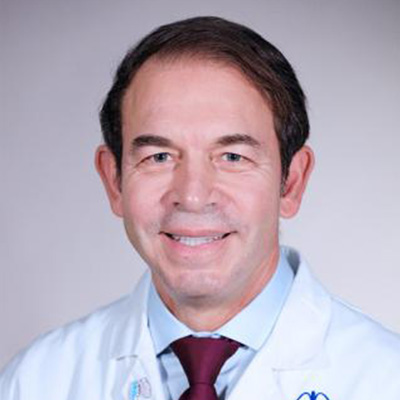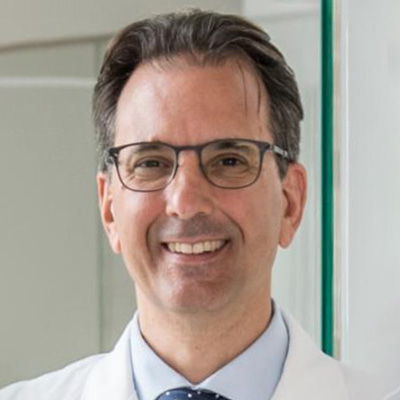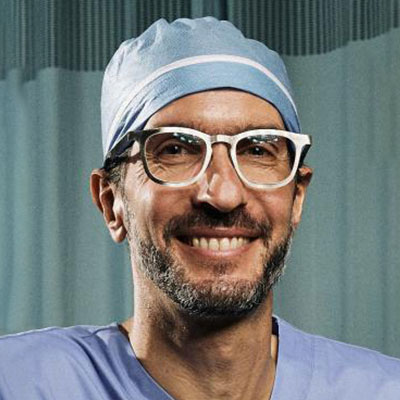When the Lung Transplant Program was first established at NewYork-Presbyterian/
Nearly four decades since the earliest lung transplants at NewYork-Presbyterian/
| Survival Rates (Adjusted) July 1, 2001 to December 31, 2022 | ||
|---|---|---|
| NewYork-Presbyterian/ n = 1,279 | UNOS – Other U.S. Centers n = 38,112 | |
| One-Year | 90% | 86% |
| Five-Year | 61% | 54% |
| Ten-Year | 36% | 29% |
Sitting as part of NewYork-Presbyterian/
“Today, our experienced faculty includes four transplant surgeons and a dedicated procurement surgeon, seven lung transplant pulmonologists, 12 clinical coordinators, who are either RNs, physician assistants, or nurse practitioners, numerous subspecialists in infectious disease, immunology, and cardiopulmonary rehabilitation, and a large, experienced inpatient physician assistant team that manages the care of post-transplant patient along with lung transplant pulmonologists,” notes Dr. D’Ovidio. “Patients are selected, discussed, treated, and managed collegially between the surgeons and the clinicians. The two services have different roles but even weight in the overall management of our patients.”
Improving Access to Lung Transplantation
Expanding Criteria for Donor Lungs
Approximately 20 to 30 percent of donor lungs are deemed acceptable for transplant as most lungs sustain too much damage at the time of donor death, precluding them from transplantation. The paucity of suitable lung donors has led the NewYork-Presbyterian/ Columbia team to explore the utilization of donors after cardiac death, a new criterion the hospital has been proactively promoting. “Utilizing these organs requires a more in-depth and dynamic assessment of the donor before procurement because once the patient has arrested there is no circulation and we are urged to procure the organ as quickly as possible,” says Dr. D’Ovidio. “Instead of hours of assessment, we are now completing the evaluation in a few minutes allowing us to be extremely successful. Many centers have been requiring the use of the ex vivo lung perfusion system in these donor lungs, despite the good quality of the organs, to accommodate the assessment of the organ outside of the donor body.”
Instead of hours of assessment, we are now completing the evaluation in a few minutes allowing us to be extremely successful. Many centers have been requiring the use of the ex vivo lung perfusion system in these donor lungs, despite the good quality of the organs, to accommodate the assessment of the organ outside of the donor body.
— Dr. Frank D’Ovidio
Many years ago, Dr. Arcasoy and his colleagues published a paper on extended donor lungs that showed that although they are not perfect, extended donor lungs yield very similar outcomes to standard lungs. “As our experience has grown, so has our tendency to stretch the limits of what kind of lungs we would accept for transplantation,” says Dr. Arcasoy. “More and more we are using lungs that were previously considered unacceptable. For example, we have been using hepatitis C positive donor lungs for a number of years because a treatment is available for hepatitis C that can cure the disease. In consenting patients who receive lungs from a donor with hepatitis C, which transmits the virus to the patient, we start them on medications and within three months the viral infection is cured.”
“We have also been utilizing organs from donors who had a social history of IV drug abuse, adds Dr. D’Ovidio. “With serological testing there has been a dramatic drop in the risk of potential and unrevealed viral infections. We have been able to increase the number of transplants by accepting donors with a history of IV drug abuse.”
Adopting a New Organ Preservation Method
Drs. Arcasoy, D’Ovidio, and Lemaitre note that lungs can be kept healthy outside of the body for a much longer time using different types of preservation methods.
“There is literature going back 30 years that documented the best temperature for preserving a donor lung was between 8 and 10 degrees Celsius,” notes Dr. D’Ovidio. “However, the field never adopted this because of difficulty with locating coolers and validating a strategy to store the lungs at that temperature. More recently, it was further documented that not only is 10 degrees better for the lung at a physiologic level, but it also provides a benefit for tissues and for the organ at a molecular level. So, there is strong evidence that the best temperature for preservation in general, but also for prolonged preservation, is in the range of 10 degrees Celsius.”
The transplant team at NewYork-Presbyterian/
I believe we are the first hospital in the United States to initiate a cold organ preservation unit with corresponding policy and regulatory requirements. This strategy, which takes us from 4 degrees Celsius to 10 degrees Celsius cold static preservation time, has allowed us to go from a range of six to eight hours in which to perform the surgery into the 18- to 24-hour range. We can procure an organ in the afternoon or evening and perform the transplant the morning after.
— Dr. Frank D’Ovidio
“Prior to adopting the new preservation method, other surgical cases would need to be bumped to accommodate the quick turnaround needed for transplant,” adds Dr. Lemaitre. “With the cold organ preservation unit, we now try to initiate the implant surgery at 10 to 12 hours from when the organ is harvested. The unit, which is housed adjacent to our OR, allows us to time the operations in a more optimal way for our patients, our surgeons, and our team. The prolonged period enables us to accommodate what is best for performing these complex surgeries and precludes the implant team from having to perform cases overnight. With this new practice, surgical cases already on the schedule can remain in place and, if necessary, we only move cases that can be rescheduled.”
The new static cold preservation approach has allowed the lung transplant team to schedule very difficult cases on a semi-elective basis when key clinicians are available and staff are at a prime energy level to facilitate a safe environment. And studies are showing that there is no difference in the outcome from the standard rush-to-implant approach to the more prolonged period of cold organ storage.
Prior to adopting the new preservation method, other surgical cases would need to be bumped to accommodate the quick turnaround needed for transplant. With the cold organ preservation unit, we now try to initiate the implant surgery at 10 to 12 hours from when the organ is harvested. With this new practice, surgical cases already on the schedule can remain in place and, if necessary, we only move cases that can be rescheduled.
— Dr. Philippe Lemaitre
“More and more centers are now adopting this strategy,” says Dr. D’Ovidio. “I now receive requests from other hospitals on how to set up such a program, what was involved operationally in establishing it, and the policy and regulatory aspects of it.”
According to Dr. Lemaitre, the possibility of using a portable 10-degree organ storage unit for transporting lungs rather than the standard cooler with ice and implications for lung preservation is also under consideration.
Expediting Donated Lung Assessment
It has been more than a decade since Dr. D’Ovidio served as principal investigator for the multicenter NOVEL (Normothermic Ex Vivo Lung Perfusion as an Assessment of Extended/Marginal Donor Lungs) Trial. “We were one of the first two centers in the country to transplant from an ex-vivo procurement,” says Dr. D’Ovidio. “We’ve had outstanding results with this process with best early and long-term survival in the trial.”
The Ongoing Value of ECMO Support
NewYork-Presbyterian/Columbia has been using an ambulatory ECMO (extracorporeal membrane oxygenation) system for 15 years and was one of the first centers to implement this kind of mechanical support for patients with end-stage lung disease.
“Previously, patients would go on full cardiopulmonary bypass machines during surgery, but now, almost 100 percent of the time, we use ECMO,” adds Dr. D’Ovidio. “This allows us to minimize coagulopathy and hemodynamic instability, which can be caused by cardiopulmonary bypass. The overall management of these patients has evolved and been refined significantly, both intraoperatively and postoperatively, to accommodate the more severe conditions we treat.”
Older Age is Not Necessarily an Obstacle
In recent years, the lung transplant team has also created a Lung Transplant Program for seniors. “We currently are transplanting patients who are older, with more than 30 percent of patients undergoing transplant over the age of 65, and some 15 to 20 percent who are over 70,” says Dr. D’Ovidio. “This was unheard of 10 years ago. It is important to not rule out a potential transplant based on later age as there’s a large patient population that may benefit, but not reaching out for help because of the perception of being too old.”
A New Allocation System Broadens the Donor Reach
Historically, waiting time has been the primary determinant of lung organ allocation in the United States. “Patients were listed and waited two to three years to climb to the top of the list to get a transplant,” says Dr. Arcasoy. “This meant a death sentence for late referrals who were very sick. The allocation system changed in May 2005 to incorporate a medical urgency measure. All of a sudden, we started transplanting sicker and sicker patients.”
But this approach was far from perfect and the donor lung allocation system continued to evolve.
Dr. Arcasoy and his colleagues have published a number of seminal papers on lung allocation systems in the U.S. and their associated problems. This includes an article published in the June 2018 issue of American Journal of Transplantation in which they discussed the geographic disparities in local donor lung supply and lung transplant waitlist outcomes. “We showed that individuals who live in the lowest lung availability areas have an 84 percent more likelihood of death or removal from the waiting list due to clinical deterioration and a 57 percent less transplantation rate.”
The lung allocation system has continued to develop since that study. “In March 2023, the allocation system was modified again to a continuous distribution system where geography matters much less, and only in terms of a point system,” continues Dr. Arcasoy. “Patients would now receive a composite allocation score based on 100 possible points. Ten points are assigned according to proximity of the patient to the donor hospital. The remaining 90 points are assigned by wait list urgency, post-transplant estimated survival, and certain biological disadvantages such as blood group, tissue sensitization, and patient size. Extra points are applied for pediatric candidates and prior organ donors. With this change in allocation approach waiting times have decreased dramatically. In fact, access to more lungs elsewhere in the country beyond our 250-mile region is one of the reasons why we are doing more transplants.”
With this change in allocation approach waiting times have decreased dramatically. In fact, access to more lungs elsewhere in the country beyond our 250-mile region is one of the reasons why we are doing more transplants…I’m hoping that the continuous distribution system, which has been in place for almost a year, will alleviate the geographic disparities between regions, where patients live, and how they are listed.
— Dr. Selim Arcasoy
Dr. Arcasoy served on the first committee that wrote the white paper on continuous distribution, defining the attributes that would make up the score. “We first looked at geographic disparities in lung transplantation, finding that depending on where you live, you may have a much higher chance of getting transplanted and much lower chance of dying or vice versa,” says Dr. Arcasoy, who played an instrumental role in developing the new continuous allocation system. “New York certainly had been a low lung availability region, meaning patients were less likely to be transplanted here and more likely to die on the waiting list. Then we looked at that same concept after the first change in the allocation system from donation service area to the 250-mile method. That helped to improve disparities, but did not resolve them. Now, I’m hoping that the continuous distribution system, which has been in place for almost a year, will alleviate the geographic disparities between regions, where patients live, and how they are listed.”
Innovating Transplant Through Clinical Research
The lung transplant team at NewYork-Presbyterian/Columbia has a number of ongoing clinical trials and research initiatives to make transplantation safer and to further optimize outcomes. Among these is the identification of a biomarker for lung allograft dysfunction.
“We have been developing a robust biobank of samples collected over the years as a basis for research with both local, regional, and national collaborators in the effort to break forward in the field,” says Dr. D’Ovidio. “One of these efforts has focused on identifying and validating bile acid in the airways as a diagnostic marker for aspiration from gastro-esophageal reflux and a predictor of lung allograft dysfunction. We have identified this as a culprit for fibrosis at a molecular level in the context of lung transplantation. After many years of studies across multiple centers to confirm our findings, we are in the process of bringing this knowledge to the clinical arena so as to provide a new clinical tool for the diagnosis of gastroesophageal reflex aspiration. The analysis is performed during a bronchoalveolar lavage at bronchoscopy, allowing us to appropriately diagnose aspiration in patients with lung disease and the specifics post-lung transplant.”
We have been developing a robust biobank of samples collected over the years as a basis for research with both local, regional, and national collaborators in the effort to break forward in the field. One of these efforts has focused on identifying and validating bile acid in the airways as a diagnostic marker for aspiration from gastro-esophageal reflux and a predictor of lung allograft dysfunction. We have identified this as a culprit for fibrosis at a molecular level in the context of lung transplantation.
— Dr. Frank D’Ovidio
Dr. D’Ovidio is collaborating in the development of the clinical tool with Serge Cremers, PhD, PharmD, Co-Director of Pathology's Clinical Pharmacology and Toxicology Laboratory and Co-Director of the Translational Therapeutics Accelerator of the Irving Institute for Clinical and Translational Research at Columbia. “When patients come in for their surveillance bronchoscopy, we will take samples that will be sent to Dr. Cremers’ lab and monitored. We expect to be the first center in the country to monitor this clinically and become a center where other transplant units can send their samples for testing,” says Dr. D’Ovidio.





